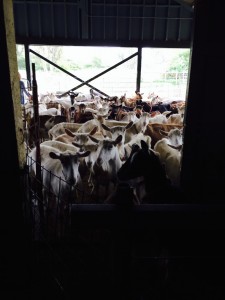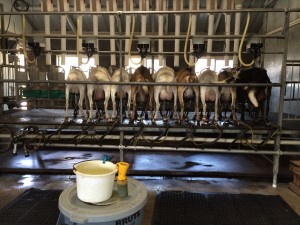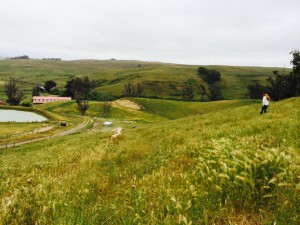This summer I worked at Toluma Farms and Tomales Farmstead Creamery, an organic goat and sheep farm & creamery. I came in with no previous extended farm experience, and minimal previous work with livestock. From June through August, I headed out each Monday from Berkeley, CA for an hour long-drive to the rolling hills above Tomales Bay. I stayed on the farm for half of my week, returning to Berkeley for weekends to bus tables at Chez Panisse Restaurant. Toluma is a beautiful 160-acre series of pastures, with an on-site milking parlor, creamery, farm house, barn, chicken coop, bees, and small raised-bed vegetable garden. Tamara and David, the owners, started the farm in 2003, while simultaneously working as a respective psychiatrist and lung surgeon in San Francisco (which they continue to do) – impressive! When I arrived at Toluma, there were a total of 3 employees on the creamery side, 1 head milker, and 2 alternating herd managers, with additional help from neighbors and volunteers. Officially, I was to be the intern focusing on pasture management, with plans to move them towards a Management Intensive Grazing system.
On my first day, and every following morning, I helped Kristy, the head milker, milk the 120 milking goats and around 50 milking sheep using electric pulsation equipment. Generally, we would begin around 8-8:30, depending on whether the creamery folk emptied the milk tank and began a chemical wash in the tank that morning. On wash days, milking was usually a little behind. With 2 people milking, the whole process could take about 3 1/2 hours for goats, the changeover of equipment, sheep and clean up. The actual milking process involved filling grain feeders and letting in lines of 12 goats, or 6 sheep, into the stalls. To protect against possible infection and mastitis, we would clean their teats with a warm cloth, strip them (3 squirts on each teat), and use a lanolin-based “predip” and iodine-based “postdip.” If we noticed hard, or cracking udders, we would apply udder balm. Before milking, we would have separated all “mastitis girls”, goats (identified as having mastitis with green ankle bands) into a separate holding pen, to be milked last. Once all lines of clean girls had been milked into the tank, we would turn off the pulsing system, and test each mastitis girl, by hand, using CMT testing (California Mastitis Testing). The mastitis milk would be directed into a plastic tub, to be donated to various people — sometimes to feed neighbor pigs or baby goats. Finally, once all milking was over, I would herd up the goats to whichever pasture was being used that day. At the beginning of the summer, I’d say I was a fairly timid herder, but quickly learned the ways. Goats were generally much easier to herd than the sheep (although naughty about sneaking back in the parlor to steal more grain) who were often skiddish or hard to get out of the parlor.
After milking was finished, I would then switch over to helping Hadley, the herd manager, take care of all other farm jobs. Projects were always switching, many of which I’ll write about in other posts, but we would consistently fill up the gravity fed water tank, and drive it to the pastures to fill water troughs for the animals. On a few pastures at Toluma, water is actually pumped directly into troughs, but there are still many which depend upon the gravity fed system. We would also take care of any sick girls in the afternoons, for example a feverish ewe with parasites or pneumonia, or Blue Moon or Babe (goats who had occasional limps). Daily, we would also lay down straw in the barn beds, put flakes of hay (grown at Toluma! I’ll get into this later) in the feeders, cleanup and reorganize the barn, check on the non-milkers, and then bring down all goats (milkers and non-milkers) to the barn for nighttime.





Speak Your Mind